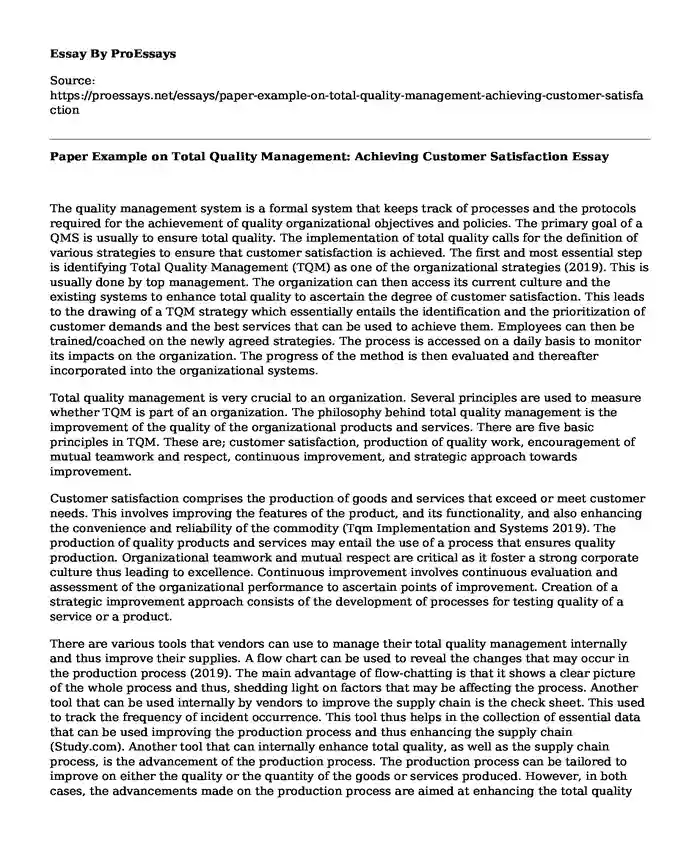The quality management system is a formal system that keeps track of processes and the protocols required for the achievement of quality organizational objectives and policies. The primary goal of a QMS is usually to ensure total quality. The implementation of total quality calls for the definition of various strategies to ensure that customer satisfaction is achieved. The first and most essential step is identifying Total Quality Management (TQM) as one of the organizational strategies (2019). This is usually done by top management. The organization can then access its current culture and the existing systems to enhance total quality to ascertain the degree of customer satisfaction. This leads to the drawing of a TQM strategy which essentially entails the identification and the prioritization of customer demands and the best services that can be used to achieve them. Employees can then be trained/coached on the newly agreed strategies. The process is accessed on a daily basis to monitor its impacts on the organization. The progress of the method is then evaluated and thereafter incorporated into the organizational systems.
Total quality management is very crucial to an organization. Several principles are used to measure whether TQM is part of an organization. The philosophy behind total quality management is the improvement of the quality of the organizational products and services. There are five basic principles in TQM. These are; customer satisfaction, production of quality work, encouragement of mutual teamwork and respect, continuous improvement, and strategic approach towards improvement.
Customer satisfaction comprises the production of goods and services that exceed or meet customer needs. This involves improving the features of the product, and its functionality, and also enhancing the convenience and reliability of the commodity (Tqm Implementation and Systems 2019). The production of quality products and services may entail the use of a process that ensures quality production. Organizational teamwork and mutual respect are critical as it foster a strong corporate culture thus leading to excellence. Continuous improvement involves continuous evaluation and assessment of the organizational performance to ascertain points of improvement. Creation of a strategic improvement approach consists of the development of processes for testing quality of a service or a product.
There are various tools that vendors can use to manage their total quality management internally and thus improve their supplies. A flow chart can be used to reveal the changes that may occur in the production process (2019). The main advantage of flow-chatting is that it shows a clear picture of the whole process and thus, shedding light on factors that may be affecting the process. Another tool that can be used internally by vendors to improve the supply chain is the check sheet. This used to track the frequency of incident occurrence. This tool thus helps in the collection of essential data that can be used improving the production process and thus enhancing the supply chain (Study.com). Another tool that can internally enhance total quality, as well as the supply chain process, is the advancement of the production process. The production process can be tailored to improve on either the quality or the quantity of the goods or services produced. However, in both cases, the advancements made on the production process are aimed at enhancing the total quality management and consequently, the supply chain.
Effective communication is also an internal factor that has a significant impact on the supply chain. Vendors should learn on the best practices of addressing customers to retain them and thus improve their profit margins. Effective communication between the vendors and the customers can lead to significant relationships and therefore, building a good reputation that may attract more sales.
External tools are very crucial in supply chain management. These tools are essentially comprised of factors that directly or indirectly affect production. Political stability is one of the factors that promote the production of goods and services. The occurrence of natural disasters is also another factor that affects the supply chain as it hinders continuous supply.
References
8 Total Quality Management Principles to Improve Processes. 8 Total Quality Management Principles | Lucidchart Blog. (2019, October 1). https://www.lucidchart.com/blog/8-total-quality-management-principles
Study.com. https://study.com/academy/lesson/five-principles-of-total-quality-management-tqm.html
TQM Implementation and Systems. ASQ. https://asq.org/quality-resources/total-quality-management/implementing-tqm
Cite this page
Paper Example on Total Quality Management: Achieving Customer Satisfaction. (2023, Dec 02). Retrieved from https://proessays.net/essays/paper-example-on-total-quality-management-achieving-customer-satisfaction
If you are the original author of this essay and no longer wish to have it published on the ProEssays website, please click below to request its removal:
- The "Luxury" Client and Expectations From a Psychological and Cultural Perspective
- Wine Producing Regions in the World Essay
- Research Paper on Dashboard Benchmark Metrics
- Essay Sample on Marketing Cultural Differences
- Research Paper on Modern Orgs: Navigating Complex Comm & Trans Needs in Global Env
- Essay Example on Business Ethics: A Guide to Creating a Positive Workplace Environment
- Essay Example on Modern Culture's Dependence on Rhetoric-Based Advertising







